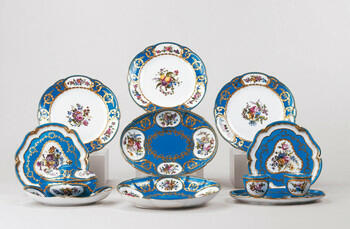-
1 of 253523 objects
A dinner service, known as the Essex Service 1764-70
Soft paste porcelain, bleu céleste ground and gilded decoration | RCIN 5000015

Sèvres porcelain factory
A dinner service, known as the Essex Service 1764-70

Sèvres porcelain factory
A dinner service, known as the Essex Service 1764-70


-
A Sèvres soft paste porcelain part dessert service with bleu céleste ground, painted with floral trails with tooled gilt husk wreaths about the borders.
Painted in polychrome with flowers and fruit: the flowers include roses, anemones (some double-headed), tulips, convolvulus, honeysuckle, oriental poppies, asters, auriculas, viburnum, cornflowers, hops, etc.; the fruit includes grapes, plums, pomegranates, peaches, figs, rosehips, redcurrants, gooseberries, etc. The gilding is formed principally of looped laurel garlands and wreaths, the former accompanied by crossed myrtle branches and the latter entwined with myrtle trails.
The Earl of Essex, from whom George IV purchased this service, was most probably, the 5th Earl, George Capel-Coningsby (1757-1839), a friend of George IV, with whom he shared political views and artistic tastes in the 1780s and 1790s. He belonged to the fashionable francophile coterie which had close links with the equally fashionable anglophile society in Paris, whose standard-bearer was the duc de Chartres. In 1784 we even find the duc de Chartres, at the behest of George IV, doing Lord Malden (the Earl’s courtesy title before he succeeded) a service. It is perhaps significant in this context that in 1816 Mr Fogg, almost certainly the dealer Robert Fogg who sold George IV numerous works of art, was stated to be the ‘agent of the Earl of Essex’ in the Customs House records in January 1816.
The service comprises 65 pieces: 34 plates, 2 round fruit dishes, 2 oval fruit dishes, 4 shell-shaped fruit dishes, 2 sugar bowls, 7 ice-cream cups, 2 round trays, 4 heart-shaped trays, 2 trays with attached jam pots, 2 bottle coolers, 4 half-size bottle coolers.
Text adapted from French Porcelain: In the Collection of Her Majesty The Queen, London, 2009
Measurements: Plates .1–.34 2.5 to 3.0 x 24.5 to 24.9, .1–.2 round fruit dishes 4.0 to 4.2 x 22.5 to 22.6, oval fruit dishes .1–.2 4.0 to 4.3 x 27.1 to 27.4 x 19.1 to 19.6, shell-shaped fruit dishes .1-.4 5.5 to 6.0 x 21.9 to 22.4 x 22.1 to 22.0, sugar bowls .1–.2 10.9 to 11.0 x 23.5 to 23.6 x 14.9 to 15.3, ice-cream cups .1–.7 6.4 to 6.6 x 7.0 to 7.5 x 5.7 to 6.0, round trays 3.3 to 3.6 x 23.1, heart-shaped trays .1–.4 3.2 to 3.9 x 20.8 to 21.1 x 20.8 to 21.2, trays with attached pots .1–.2 9.1 x 24.6 to 25.2 x 17.5 to 17.8, bottle coolers .1–.2 18.5 to 18.6 x 26.0 to 26.5 x 20.5 to 20.9, half-size bottle coolers .1–.4 16.7 to 17.0 x 22.7 to 23.0 x 18.0 to 18.2 cmProvenance
A dinner service, known as the Essex Service, first recorded in the Royal Collection in the Confectionary at Carlton House in an inventory dated 1826 ‘No. 130. A Dessert Service of light blue and gold Seve Porcelain' noted as purchased from Lord Essex.
-
Creator(s)
(porcelain manufacturer)(nationality)(porcelain painter)(porcelain painter)(porcelain painter)(porcelain painter)(porcelain painter)(porcelain painter)(porcelain painter)(porcelain painter)Acquirer(s)
-
Medium and techniques
Soft paste porcelain, bleu céleste ground and gilded decoration
Category
Other number(s)
Place of Production
Sèvres [France]